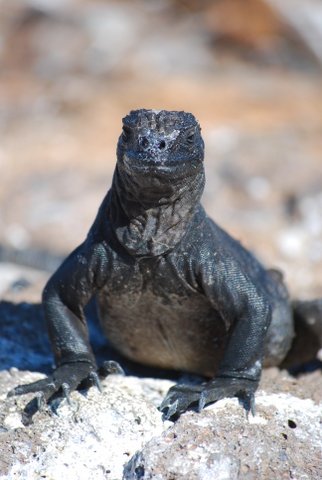
One of my favorite trips ever was to the Galapagos Islands, via a small cruise ship, much like the one contributing writer Robert Waite took in his compelling narrative below. The fellow pictured above, a marine iguana with a face only a mother (or mate) could love, is one of countless friendly creatures my wife and I encountered during our eight-island cruise. But I’ll leave it to Bob to chronicle his own experiences, which complete his trilogy on traveling to Ecuador, including visits to the colonial-era capital, Quito, and the Amazon.
By Robert Waite
Santa Cruz Island, Galapagos – Want to feel young again, even if you are in your sixth or seventh decade? Head to the Santa Cruz highlands, where you will be a veritable spring chicken compared to the Galapagos giant tortoises ambling about.
Many tortoises reach 100 years of age or more, and one — a female named Harriet — reached at least 175 before checking out. To put this in perspective, Harriet might have been hatched around the time Charles Darwin visited the archipelago in 1835 while researching his Origin of Species.
We are taken to the Santa Cruz highlands shortly after arriving on our boat at Puerto Ayora on the island’s south coast. As our bus moves away from the sea and upwards in elevation, the barren, volcanic cinder-encrusted terrain gives way to lush greenery.
Among the giant tortoises we encounter are two about the size of those snow saucers you might have used as a kid, but inverted. While not exactly frolicking in the grass, they are clearly making hay (or baby tortoises) while the sun shines. Our vehicle slows and there is an audible tittering and clicking of cell phone and conventional cameras. Voyeurism lives.
Judging by their size (they can reach upwards of 500 pounds), the pair are likely in their 90’s. I’m no expert of the sex lives of reptiles, but they seemed to be doing just fine, with no help from Viagra.
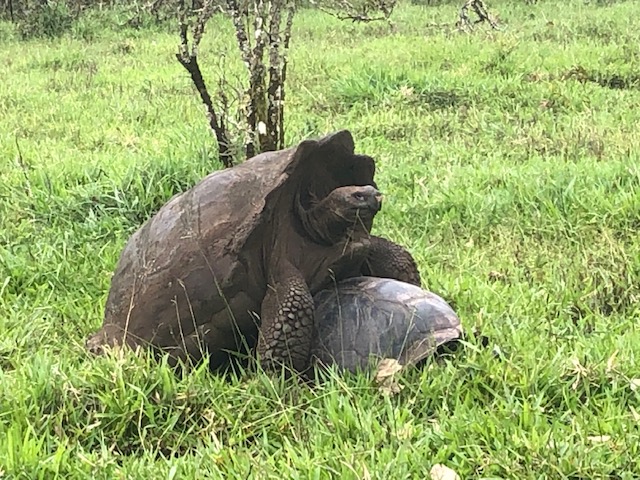
Darwin Research Center a Must-See
After spending more than an hour at the Tortoise Reserve, we make our way to the Galapagos National Park Office and the Charles Darwin Research Station, both located back near town.
The Research Center is must-see. Of special interest is Tortoise Breeding Center Fausto Lierena. Established in the 1960s, its mission is to preserve endangered subspecies (of which there are many) by providing a safe place to hatch and then returning them to their habitat.
The danger to these subspecies is very real, as illustrated by “Lonesome George,” the last of his kind, who is preserved and on exhibit. Hailing from the smaller Pinta Island in the northern reaches of the archipelago, he was lonesome indeed, having died childless in 2012.
Also on exhibit are items related to other of the Galapagos’ flora and fauna – and to Charles Darwin, who will be your constant companion wherever you go.
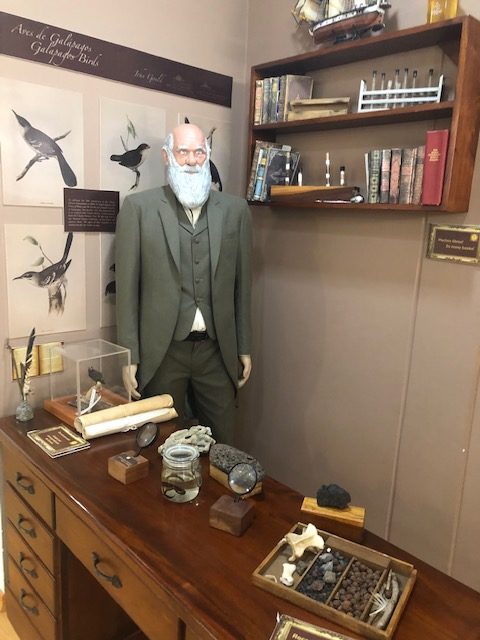
Choices of Lodging and Transport
Where and how you go is entirely up to you.
Some visitors — mostly budget-conscious and traveling on their own — arrive in Santa Cruz Island, make the touristic town of Puerto Ayora (pop. 12,000) their base of operations, then take day excursions to other islands. Other like-minded travelers do the same at San Cristobal Island, located on the eastern edge of the archipelago.
Still others arrive and hop on one of a variety of vessels, heading out for cruises of anywhere from four days to two weeks.
Our choice – and our recommendation to you – is to go the cruise route, on a smaller vessel and for as long as you can.
We had begun our visit to the Galapagos four days prior to our encounter with the highland tortoises, arriving at San Cristobal after a 600-mile flight from Guayaquil on Ecuador’s Pacific coast (the Galapagos are part of Ecuador).
San Cristobal and Santa Cruz are unique, in part because, unlike most of the other 17 “major” islands that make up the Galapagos, they have enough water to sustain human life.
There is of course life on the other islands – the very diversity of life Darwin famously chronicled – but, with the additional exception of Isabela Island, no permanent human habitations. So, unlike San Cristobal and Santa Cruz, most of the islands possess no curio shops selling “I Love Boobies” T-shirts — an eye-rolling nod to the resident blue- and red-footed booby bird population — but do offer much to see.
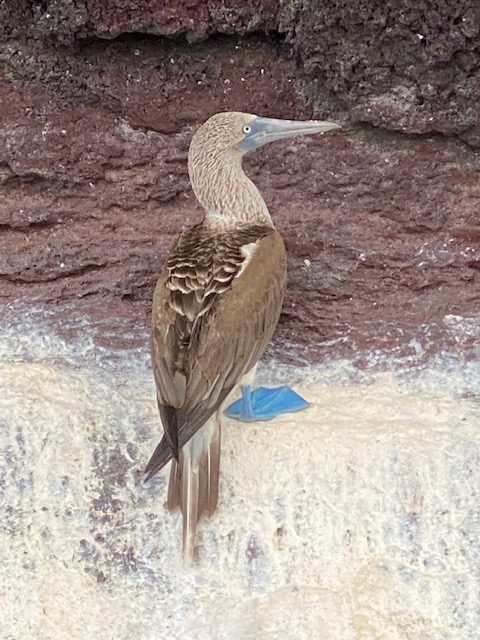
Small ships Offer Big Advantage
In planning the trip we had decided we also wanted to experience what was in the waters surrounding the islands. Thus we looked for cruises offering a combination of shore hikes and snorkeling. And we sought out companies that could offer a more extended experience, on the theory that this was probably going to be our one and only visit.
Based on previous experiences in places like Antarctica and Canada’s Haida Gwaii, we also wanted a smaller vessel. The big advantage of a smaller ship is that some island locations have capacity restrictions, limiting the number of people who can go ashore.
With larger ships this can result in a portion of the guests listening to a lecture about a location, rather than actually setting foot on the island. Or it might reduce the total number of shore landings.
In the end, we selected the yacht “Anahi,” capable of carrying 16 guests and a crew of ten, including the captain and a certified guide. And we cobbled together the company’s four- and seven-day itineraries, allowing us a full 11 days to see much more of what the Galapagos has to offer.
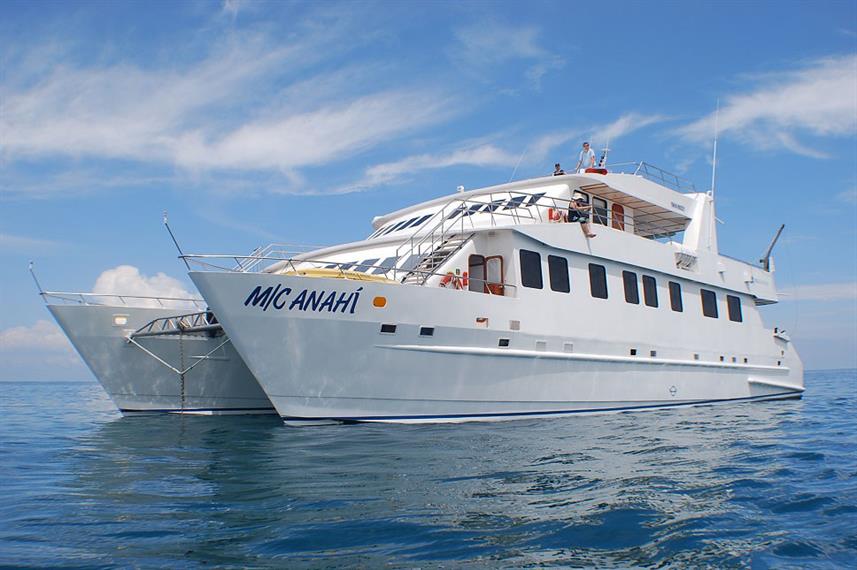
Fellow Travelers
It should be noted that a potential challenge with a small boat is that you never know who you’ll be thrown in with – or how to escape them. On this particular voyage, which included a partial changeover of guests and a switching of guides, we were fortunate enough to share the experience with, among others, three amiable American brothers, the Stobie boys (accompanied by one entertaining spouse, Nancy Stobie); a French couple; a German couple; a mysterious Englishman dubbed “the spy”; and a half-dozen mildly rambunctious Spaniards.
Our guide on departure from San Cristobal, Roberto, was superbly qualified, but not overly serious. A former schoolteacher, he clearly enjoyed performing on land and sea.
Note that the Galapagos guides are not technically employed by the cruise lines, but by Ecuador’s National Park Service. Our second guide, Galo, who joined us at Puerto Ayora, was equally adept. Both knew their subject matter, and how to keep guests entertained as well as informed about each island’s history as well as its amazing flora and fauna.
As the ship, a stable catamaran, made its way in a looping, clockwise direction, we first visited Espanola Island, one of the oldest in the Galapagos. It featured Suarez Point — home to rare waved albatrosses with giant wingspans — and Gardner Bay, known for its sea lion colonies.
We then went on to Floreana Island, which featured evocative places like Cormorant Point, Devil’s Crown, and Peace Heaven Highlands. Its history included Post Office Bay, where sailors would drop off letters in hopes that other sailors headed in their intended destinations would pick them up and deliver them. And it’s still in use; we left a letter and took back two with us for delivery in Ottawa.

The “Big 15” of Flora and Fauna
As for the flora and fauna, where Africa has its “Big Five,” the Galapagos — not to be outdone — has its “Big 15”.
Along with giant tortoises, sea lions, and albatrosses, you can observe all manner of land and marine iguanas (which Herman Melville dubbed “the ugliest creatures on the planet”), boobies (red- and blue-footed), fur seals, frigatebirds, sea turtles, cormorants, flamingos and – yes – penguins!
And almost without exception, the wildlife is untroubled by your presence, even to the point that you can find yourself up to your ears in iguanas if you don’t watch your step.
One reason for the variety and abundance of life on and around these islands is the flow of the chilly, nutrient-rich Humboldt current. While you are at the equator, the water temperature might have you believing you’re in the Gulf of Maine.
Hence the presence of the only penguin species found north of the equator.
We first encountered this smallish Galapagos penguin on the northern reaches of Isabela Island, where they lurk in the caves and crevices of the coastal volcanic rock. Like all penguins, they are cute but a bit ungainly on land; underwater, however, they are sleek, swift and elegant.
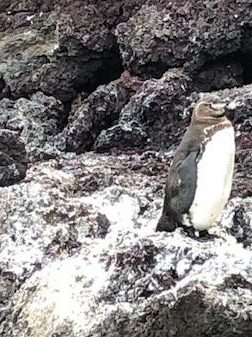
Day and Nighttime Routines
Our days and nights settled into comfortable routines. We would often move from island to island at night. After breakfast, we would pile into the ship’s two zodiac-like vessels and make for shore, setting out for a walk for an hour and a half or so. Then it was back to the Anahi for a change into snorkeling gear and another hour or so of underwater exploration.
After lunch (and often after the captain had moved the boat to a different location), a second shore walk was followed by another snorkel.
There was as much to see underwater as above. We especially enjoyed the green sea turtles, which seemed oblivious to our presence as they floated by us, and the sea lions, which all but pressed their noses against our facemasks. We were often accompanied by the captain, an excellent diver, who seemed to relish pointing out sharks.
Given all this activity, and despite the fact that there was a well-stocked bar and a hot tub on the second deck, most of us were in bed and fast asleep not long after 9 pm. Except, of course, for those rambunctious Spaniards.
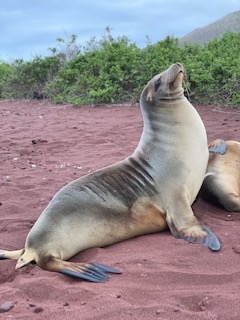
Birds, Birds, Birds
Everywhere we went – Isabela, Fernandina, Rabida – there was more wildlife to see, including an astonishing amount of birdlife. Darwin may have been fixated on finches, but there are so many species that ardent birders would run out of room in their tally books.
There are 60 native species, plus another 30 or so which make the islands home from October to March.
Our favorites included the boobies (but not enough to buy the t-shirt) and the male Magnificent Frigatebird, with its bright red inflatable throat-pouch. It was enough to make you want to come back as a female Frigatebird.
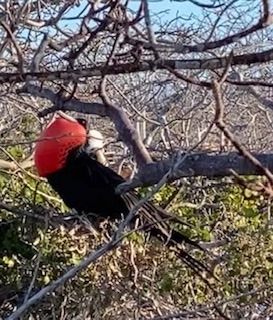
It should be noted that travelers should be realistic about their abilities when considering which type of Galapagos tour to book. While our many walks, hikes and snorkels were not extraordinarily difficult, individuals with mobility issues would be advised to look for alternatives.
We finished our 11-day odyssey by sailing past the politically incorrectly-named island of Chinese Hat, then stopping at North Seymour Island — where you can watch blue-footed boobies do a mating dance — before disembarking at Baltra and flying back to Quito.
As we were among the first tourists that the captain, guide, and crew members had seen in over 15 months, their farewells were warm and genuine. We may never get back to the Galapagos – but we will certainly never forget our time there.
IF YOU GO
There are two entrance airports for the Galapagos. One (originally built by the Americans after Pearl Harbour) is on Baltra, an island just north of Santa Cruz; the other is on San Cristobal. No direct international flights are allowed – you must depart from either Quito or Guayaquil in Ecuador on one of two carriers – LAN or Avianca.
Check entry requirements well before traveling. At the time we visited, the COVID quarantine period had been dropped, but visitors needed proof of vaccination and a negative PCR test.
Ecuador uses the U.S. dollar as its currency (similar to Panama).
Away from the towns, you will have no internet access from your boat. Enjoy.
A book worth reading prior to going to Galapagos is Henry Nicholls’ The Galapagos (New York, Basic Books, 2014). Nicholls provides a highly informative and broadly engaging blend of history, geology, biology, and personal commentary.
Our land arrangements were made through Enchanting Travels, Greenwood Village, Colorado.
The Anahi provides wetsuits for a daily fee. Despite the fact that you are at the equator, the cold Humboldt current makes this a good option.
The author paid for all of his own travel expenses and did not reveal that he was writing on travel until near the conclusion of the stay.
Author Bio:
Contributing writer Robert Waite previously chronicled his recent travels to Quito, Ecuador; Ecuador’s Amazon headwaters; and the nation of Panama for clarknorton.com.
Top photo credit: Clark Norton












One Response to Galapagos Islands: Go at Least Once in a Lifetime